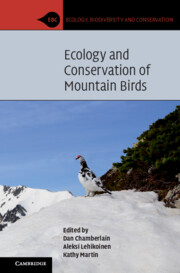Book contents
- Ecology and Conservation of Mountain Birds
- Ecology, Biodiversity and Conservation
- Ecology and Conservation of Mountain Birds
- Copyright page
- Contents
- Contributors
- Preface
- Acknowledgements
- 1 Mountain Birds and Their Habitats
- 2 Avian Adaptations to High Mountain Habitats
- 3 Global Bird Communities of Alpine and Nival Habitats
- 4 Birds of Treeline Ecotones
- 5 Population Trends of Mountain Birds in Europe and North America
- 6 Climate Change Impacts on Mountain Birds
- 7 Anthropogenic Activities and Mountain Birds
- 8 Modelling Large-Scale Patterns in Mountain Bird Diversity and Distributions
- 9 The Alpine Avifauna of Tropical Mountains
- 10 Priorities for Information, Research and Conservation of Birds in High Mountains
- Bird Species Index
- Subject Index
- Plate Section (PDF Only)
- References
2 - Avian Adaptations to High Mountain Habitats
Solving the Challenges of Living in Alpine Ecosystems
Published online by Cambridge University Press: 30 June 2023
- Ecology and Conservation of Mountain Birds
- Ecology, Biodiversity and Conservation
- Ecology and Conservation of Mountain Birds
- Copyright page
- Contents
- Contributors
- Preface
- Acknowledgements
- 1 Mountain Birds and Their Habitats
- 2 Avian Adaptations to High Mountain Habitats
- 3 Global Bird Communities of Alpine and Nival Habitats
- 4 Birds of Treeline Ecotones
- 5 Population Trends of Mountain Birds in Europe and North America
- 6 Climate Change Impacts on Mountain Birds
- 7 Anthropogenic Activities and Mountain Birds
- 8 Modelling Large-Scale Patterns in Mountain Bird Diversity and Distributions
- 9 The Alpine Avifauna of Tropical Mountains
- 10 Priorities for Information, Research and Conservation of Birds in High Mountains
- Bird Species Index
- Subject Index
- Plate Section (PDF Only)
- References
Summary
Alpine birds face many challenges to live in habitats characterized by low temperatures, high winds, short growing seasons and delayed breeding schedules. Breeding in alpine environments is always a race against time due to the shortened egg laying period and frequent storms that may result in delayed development or reproductive failure. Since daily temperatures in the alpine zone can range from below freezing to >450C, developing embryos may require cooling as well as heating to maintain homeothermy. To cope with such conditions, birds breeding in alpine habitats have developed physiological, morphological and behavioural adaptations, and have adopted a slower lifestyle where they may produce fewer offspring each year compared to populations at low elevations, but may live longer. In the northern hemisphere, only a few birds live exclusively in the alpine zone, with many mountain species breeding in both alpine and lower elevation habitats, while in the Southern Andes, most alpine birds breed exclusively above the treeline. In summary, there may be high ecological costs to living in open habitats at high elevations. However, alpine birds likely experience lower levels of interspecific competition, habitat degradation and parasites and diseases than birds living at lower elevations.
Keywords
- Type
- Chapter
- Information
- Ecology and Conservation of Mountain Birds , pp. 35 - 89Publisher: Cambridge University PressPrint publication year: 2023



